Gypsum ceilings in interior design
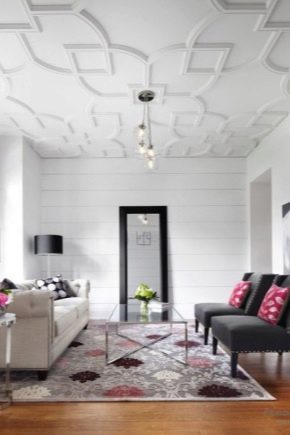
Gypsum ceilings have long occupied their niche in the field of design and construction. The demand for these ceiling products is explained not only by a wide base of coatings intended for any design project, but also by the ease of installation. For this reason, this look has earned particular popularity among many other finishes.
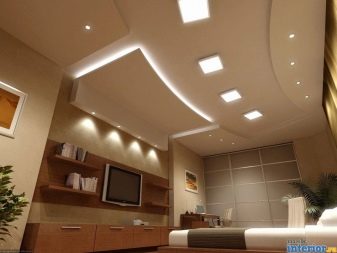

Peculiarities
The gypsum surface is very diverse. Sometimes it is a simple plaster tile covering, and sometimes it is a ceiling with complex stucco molding. The second option looks especially beautiful and is in great demand.
Often it is decorated with various colors, including gilding, which gives the interior a special charm and high cost.


The first thing a person sees before going to bed and in the morning upon waking up is, of course, the ceiling. That is why it is especially important that it is pleasing to the eye. In this case, a smooth white surface cannot become an interesting design solution; over time, such a ceiling can get bored, causing a feeling of emptiness.



The ceiling is an independent part of the interior, which, like furniture and wall decoration, should not yield to the originality of the design. Fitting into the overall style of the room, it undoubtedly complements the overall design picture. It will be interesting to look at a gypsum surface with inserts: it can be geometric shapes or some other kind of drywall boxes.
They will not only hide surface imperfections, but also give the ceiling covering a special gloss.



Advantages and disadvantages
A striking advantage of any gypsum coating is its ability to make the ceiling surface perfectly flat, hiding all flaws. It can be painted in any color and applied in a variety of patterns.
Such a ceiling will always emphasize the individuality of the owner, thanks to the variety of styles of types and forms.

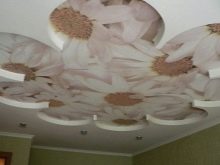

In addition, it is designed so that electrical wiring, soundproofing material and other communications can be hidden inside its structure. It is also convenient to integrate lighting devices into it.



In general, all the advantages of gypsum coatings look like this:
- Moisture resistance. Unlike conventional ceilings, gypsum will withstand any level of moisture. This makes it suitable for rooms with high humidity.
- Heat resistance. Such a ceiling is not afraid of any temperature drops.
- Fire resistance. The gypsum ceiling does not burn, thereby observing all fireproof conditions.
- Hygroscopicity. Gypsum material has the unique ability to absorb moisture and release it to the surface. Thus, a comfortable atmosphere is always maintained in the room. Such ceilings are installed in government agencies, where special attention is paid to sanitary standards.



- Sound-reflecting and sound-absorbing qualities. These two different properties depend on the design of the ceiling. If silence in the room is required, then a gypsum ceiling with a perforated surface is suitable, and for sound reflection - with a smooth one.
- Decorativeness. It is no secret that the plaster ceiling has the most striking design variety. Thanks to this, you can choose a ceiling for every taste, and use it to implement the most daring design solution.
- Environmental friendliness. Gypsum is a natural material that is not harmful to health.



- Durability. The material is quite durable and has no shelf life restrictions.
- Simple installation.Plaster ceiling installation only takes a few hours. Luminaires and fire alarms can be easily integrated. Their installation can also be mastered by hand.
- Reflective properties. Due to the fact that the surface of the ceiling reflects light well, the room appears more spacious.



The gypsum ceiling also has its drawbacks:
- Despite the moisture resistance of most types of gypsum material, there are panels that are susceptible to high levels of moisture. Such a ceiling requires special processing so that mold does not form inside it. But even the most water-resistant material will not survive the flood test. Such a ceiling will be subject to immediate dismantling.
- Many owners may be confused by the fact that the gypsum ceiling significantly reduces the height of the room. In addition, it is not recommended to install it in newly built wooden houses - the material sags over time, and flaws appear on the very surface of the ceiling, leading to cracks.



- If the gypsum is chosen of insufficient quality, then over time it can lose its color and impeccable appearance.
No matter how simple the installation may seem, it is quite difficult to install such a ceiling with your own hands or alone.

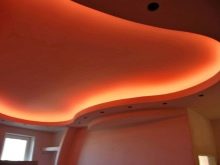

Design Tips
- It is best to choose light colors for decoration. Such a ceiling will always visually add extra centimeters to the height of the room.

- A glossy and lacquered surface will always look better than a matte finish. It perfectly reflects and diffuses light. Stretch multi-level ceilings require a sufficient wall height.

- If you want to zone the room, it is recommended to choose multi-level ceilings with lamps.

Varieties
Any gypsum tile has a double base, usually a metal or wood frame and a panel attached to it with fiberglass mesh.


There are several types of slabs: standard, design, tape and transitional.
The standard form of gypsum tiles is a square with an area of 0.24 sq. m.

Design models of slabs can be of the most diverse shapes: cellular, coffered or domed. These tiles are always more expensive.


Tape slabs allow you to connect the surface into a single, even structure. Also, with the help of them, you can create all kinds of ornaments. The adapter plates serve the same function. Thanks to the large number of fasteners, they create the illusion of an absolutely integral surface.


Gypsum is also used to make types of surfaces that go well with other types. Plaster skirting boards can be attached to other types of ceilings. Sockets for a chandelier or decorative stucco molding for any flat surface in the room will look good from it.


How to choose?
The most common type of coverage is single-level. It is usually used in rooms with low ceilings. Recessed LED spotlights will help in this case to zone lighting and save electricity.

For a children's room, panels with colored stencils are suitable. Panels with a vibrant color arrangement in the middle are also suitable for a living room.


The multi-level option is suitable for spacious, high rooms. In addition, such a surface allows you to give free rein to design ideas. Unlike single-level coatings, in this case, you can play not only with color, but also with design. Curved designs can be easily combined with mirrored surfaces for an interesting visual effect. Glass, gypsum stucco molding, wood, plastic also go well with the plaster surface.
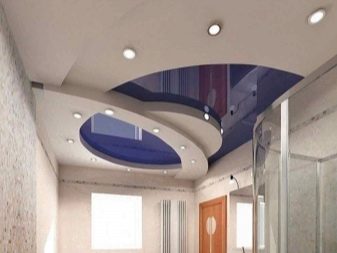

Correctly selected stucco molding can give the room a classic and even antique style. You can also create a ceiling with imitation of wooden beams from drywall. If the room is small and requires light, then it is better to select white drywall.


Coverage lighting can also be different, it all depends on the design goals.There are classic lamps, multi-shade and even hidden, which are installed between the tiers.


DIY installation
Installation of a gypsum ceiling is attractive because it is easy, fast enough and practically without traces of construction debris. This is one of the main reasons for its popularity.
Measurement and marking are the first points during installation. All the nuances in transitions and joints of the structure are taken into account, which depend on the total amount of work and the design plan.


Having taken up the installation with your own hands, you should arm yourself with a standard set of professional tools: a puncher, a screwdriver, a tape measure, a hydraulic level, a hammer, and a grinder.
The grinder is most often used when installing multi-level ceilings; when installing other types, it may not be needed. The markings are applied taking into account the future height of the ceiling in order to assess the surface visually in advance.


The ceiling will be lowered by a few centimeters and installed according to the design of the room, which is also taken into account during installation. For example, the classic style does not imply multi-level ceilings, but for a high-tech or modern style, an option with several levels is quite suitable. The plaster ceiling goes well with the arches.


Two-level ceilings can be decorated with stylish lighting. Suspended luminaires are increasingly used today. It is best to choose them in the corridor.


Gypsum today is the most affordable and demanded material for finishing ceilings. Largely due to the attractive price, ease of installation and a variety of forms, it has long replaced the usual plaster. With its help, you can create truly exclusive designs that will delight you for a long time.
In the next video, you will see how to make a plasterboard ceiling with your own hands.













The comment was sent successfully.